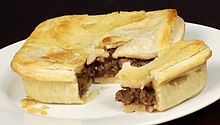Meat alternative
This article needs additional citations for verification. (November 2009) |




A meat analogue, also called a meat substitute, mock meat, faux meat or imitation meat, approximates certain aesthetic qualities (primarily texture, flavor and appearance) and/or chemical characteristics of specific types of meat. Many analogues are soy-based (see: tofu, tempeh) or gluten-based.
Generally, meat analogue is understood to mean a food made from non-meats, sometimes without other animal products, such as dairy. The market for meat imitations includes vegetarians, vegans, non-vegetarians seeking to reduce their meat consumption for health or ethical reasons, and people following religious dietary laws, such as Kashrut or Halal. Hindu cuisine features the oldest known use of meat analogues.[citation needed]
Meat analogue may also refer to a meat-based and/or less-expensive alternative to a particular meat product, such as surimi.
Vegetarian meat, dairy and egg analogues

Some vegetarian meat analogues are based on centuries-old recipes for seitan (wheat gluten), rice, mushrooms, legumes, tempeh, or pressed-tofu, with flavoring added to make the finished product taste like chicken, beef, lamb, ham, sausage, seafood, etc. Yuba and textured vegetable protein (TVP) are other soy-based meat analogues. The first is made by layering the thin skin which forms on top of boiled soy milk.[1] the second is a dry bulk commodity derived from soy and soy protein concentrate.
Some more recent meat analogues include mycoprotein-based Quorn (which usually uses egg white as a binder; only Vegan Burger is suitable for vegans), and modified defatted peanut flour and Valess (which is a sort of cheese, made from cow milk and seaweed).
Beyond Meat, a company based in El Segundo, California, has developed a process in which soy and pea proteins are blasted "through an alternating cascade of high heat and high pressure in a stainless steel machine."[2] The resulting product bears such a close resemblance to chicken meat that it has attracted the interest of investors such as Bill Gates and the venture capital firm Kleiner Perkins Caufield & Byers.[2] The imitation chicken product has been sold at Whole Foods Markets since 2012.[2]
Dairy analogues may be composed of processed rice, soy (tofu, soymilk, soy protein isolate), almond, cashew, gluten (such as with the first non-dairy creamers), nutritional yeast, or a combination of these, as well as flavoring to make it taste like milk, cheeses, yogurt, mayonnaise, ice cream, cream cheese, sour cream, whipped cream, buttermilk, rarebit or butter. Many dairy analogues contain casein, which is extracted dried milk proteins, making them unsuitable for vegans.
Egg substitutes include tofu, tapioca starch, ground flax seed, mashed bananas, applesauce and commercially prepared products that recreate the leavening, binding and/or textural effects of eggs in baked goods.
Lab-grown animal tissue
Biologists have long researched methods for growing muscle tissue in laboratory conditions. Advocacy group PETA has offered a $1 million prize to the first company that can bring lab-grown chicken meat to consumers by 2012.[3]
Surimi and similar meat-based meat analogues
Surimi, a processed hash of fish plus flavorings, is used to make products such as imitation crab meat. In some regions,[where?] "surimi" refers only to products made from fish, but elsewhere[where?] may refer to other products (e.g., turkey dogs produced from turkey in North America), which are then also called "surimi".[by whom?]
Examples of surimi include:
- Surimi from fish, such as imitation crab, imitation shrimp, or imitation lobster
- Surimi from turkey, such as hot dogs, brats, sausage, salami, lunch meats, loafs, burgers, bacon, ham, or ground
- Other processed poultry products, such as emu, in the same forms described above for turkey.
Surimi products are often marketed as "imitation" meats (e.g., "imitation crab meat", "imitation shrimp").
See also
- List of meat substitutes
- Tofurkey, the US Thanksgiving public holiday vegetarian meal centerpiece, consumed by some vegetarians or vegans, for the sake of nostalgia
Notes
- ^ Patterson, Daniel. The Way We Eat: I Can't Believe It's Tofu, New York Times, 2006-08-06. Retrieved on 2009-02-26.
- ^ a b c Pierson, David. (2013, November 9). Substitute-meat makers' art imitates life. The Los Angeles Times.
- ^ Lab-Grown Meat a Reality, But Who Will Eat It? : NPR
Further reading
- Wyrick, Jason (March 2009). "Meat Subs" (PDF). Vegan Culinary Experience. Retrieved 2011-04-15.
